The Tramways of Belém (original) (raw)
The Tramways of
capital of Pará state
Brazil
BY Allen Morrison
This is a website about the steam-powered, horsedrawn and electric tramways that operated in the Brazilian city from 1869 to 1947 – and the new electric tramway that was built there in 2004. For more information on early tramway history, see the Belém chapter of my book, The Tramways of Brazil.
Part 1: 1869-1947
Belém's first street railway was built in 1869 by the U.S. consul to Pará, James B. Bond. The line began at the Cathedral and ran east along Rua Pedro Rayol (Rua Padre Champagnat today) and Ruas João Alfredo and Santo Antônio, then southeast along Av. 15 de Agosto (Pres. Vargas today) and Av. Nazareth (Nazaré) to Largo de Nazareth (Praça Justo Chermont) [see map]. This was also the route of Belém's first electric tramway in 1907 and is the route (in part) of its new heritage tramway today.
Track gauge of the 1869 line was 1435 mm, established by the Botanical Garden Rail Road in Rio de Janeiro the year before, and the first trams were pulled by small steam locomotives. The line was extended in 1871 to São Brás [see map], where the mediocre photograph below was taken [col. AM]:

Mules began pulling trams along the same route in the 1870s and steam operation ended in 1894. Here is Rua João Alfredo [see map] about 1900 [postcard, col. AM]:
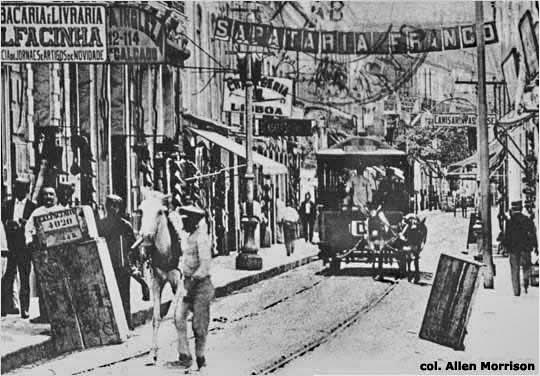
In addition to the 1435 mm gauge line, another animal tramway, of 750 mm gauge, developed in the 1870s. The postcard view below shows both tramways about 1905 at their terminals on Praça do Relógio – at the intersection of Av. 16 de Novembro (Av. Portugal) and Rua João Alfredo [see map]. Note that both the 750 mm gauge line on the left and the 1435 mm gauge tramway on the right used the same type U.S.-built cars [col. AM]:

Siemens & Halske installed electric street lighting in Belém in 1894 and an English company, Pará Electric Railways & Lighting Co., opened a 1435 mm gauge electric tramway on 15 August 1907. The first line followed the same route as the 1869 steam tramway, except that inbound cars ran west on Rua Senador Manuel Barata and east on João Alfredo [see map]. To see a large photograph of the reconstruction of Rua João Alfredo in 1907, click here.
The terminal of the new electric line was on Av. 16 de Novembro at Praça Dom Pedro II, adjacent to Praça do Relógio shown in the horsecar view above. The postcard below, made soon after the inauguration, shows an electric tram about to turn right onto Rua João Alfredo [col. AM]:

Here is a view of Rua João Alfredo after an electric tram has turned onto it from Av. 16 de Novembro. The photographer is looking east [see map]. Note abandoned horsecar tracks, of both gauges, in the foreground. The 3-story structure on the left is Hotel América. A completely new tramway was built along this same street in 2004 [col. AM]:
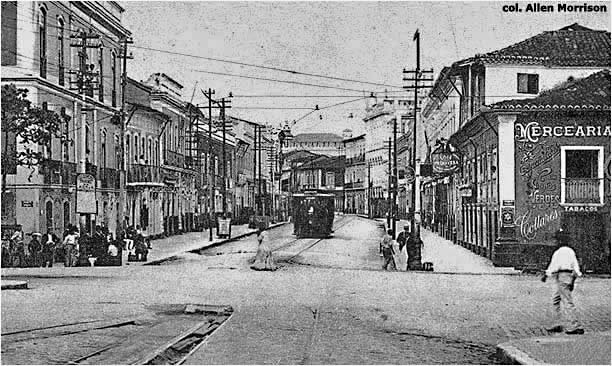
To see the original, large color version of this postcard, showing more of the street and buildings, click here.
For a while, some of the new electric trams pulled the old horsecars as trailers. The photograph below, which was reproduced in an English magazine, was taken on Av. 15 de Agosto, called Av. Presidente Vargas today [see map] [Tramway & Railway World, London, 4 March 1909, p. 167]:
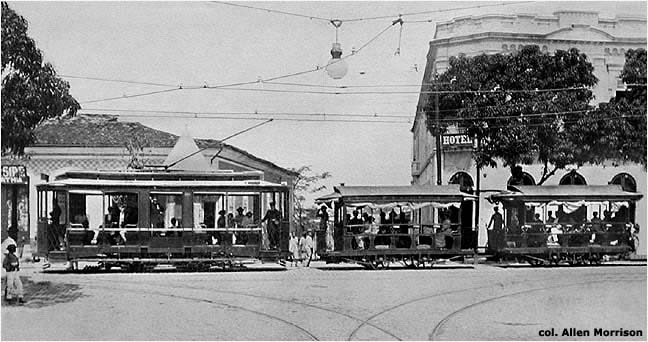
Another view of Rua João Alfredo [Le Brésil: ses richesses naturelles, ses industries. Paris, 1909; col. Paulo Pacini]:
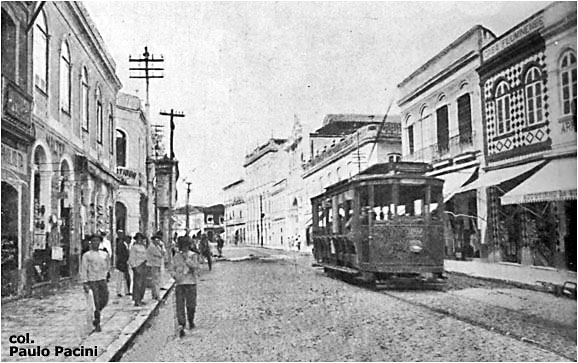
As the electric system expanded, more tracks were laid on Av. 16 de Novembro and the horsecar rails were removed. In the postcard view below, Rua João Alfredo is barely visible on the left [see map]. That's Hotel América behind the kiosk [col. AM]:
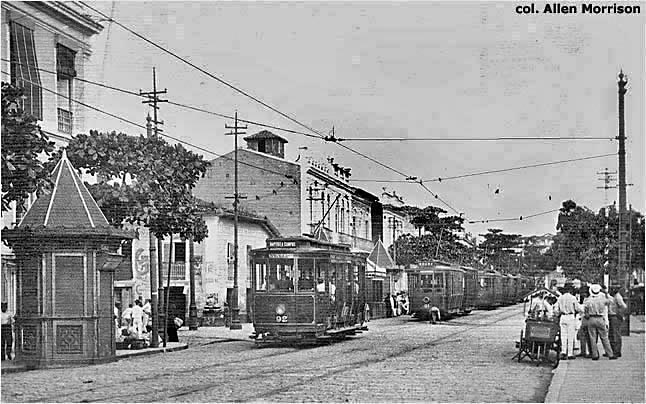
The postcard below shows an overhead view of this same spot on Av. 16 de Novembro, with Praça Dom Pedro II on the right [see map]. The photographer was probably on the roof of Hotel América [col. AM]:
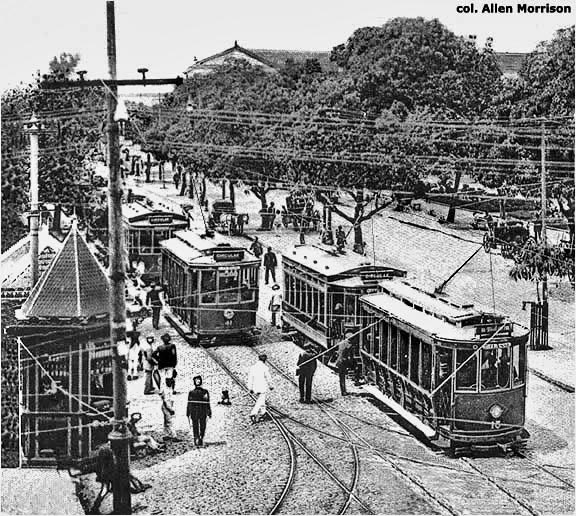
Praça do Relógio (Clock Square), Av. 16 de Novembro, Rua João Alfredo and Praça Dom Pedro II – here is a 1930s panorama of the places where some of the preceding photographs were taken [see map]. That's Hotel América behind the trams on the left [col. AM]:
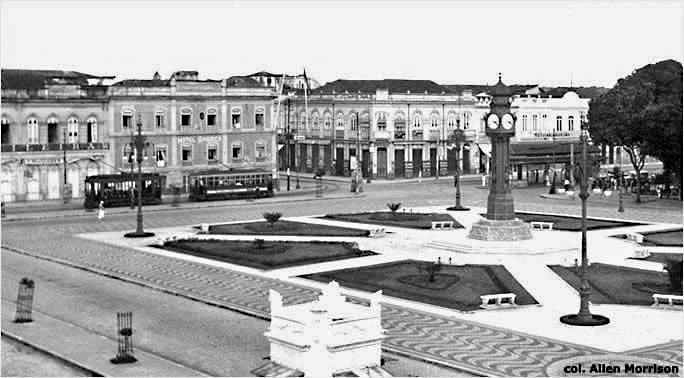
The 1940s view below is south on Av. 15 de Agosto – called Av. Presidente Vargas today – a few blocks below its intersection with Rua Santo Antônio [see map] [col. AM]:
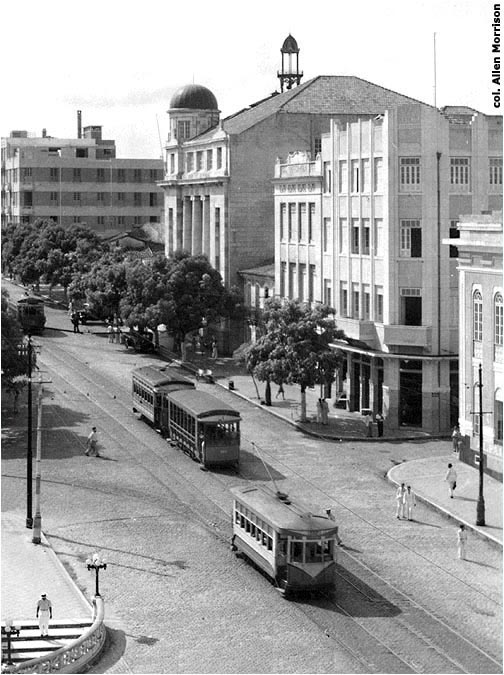
The last photograph in this section is dated 28 February 1946. The tram is a reconstruction of one of 20 large cars that Pará Electric imported second-hand from Cardiff, Wales, in 1940. Belém's electric tramway system closed on Saturday 27 April 1947, less than 40 years after its inauguration [Charles S. Small]:
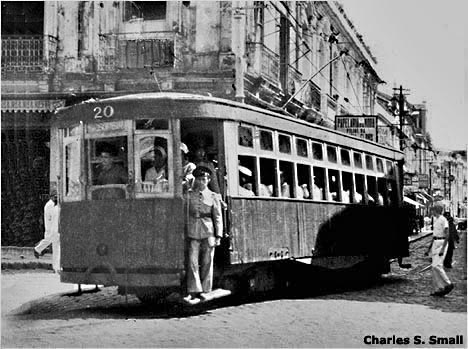
The steam railroad to Bragança [see map] disappeared in 1965 and for the next half-century all public transport in Pará state was by gasoline-powered vehicles using rubber tires.
(As noted in the first paragraph above, there is more information about the early development of the Belém tramways in the Belém chapter of my book, The Tramways of Brazil. For the sources of that information, see the listings under "Belém (PA)" in the Bibliographies for Each City section of that book.)
This page was uploaded on 16 September 2004 Please send comments, corrections & suggestions to Allen Morrison Visit my homepage aboutElectric Transport in Latin AmericaCopyright © 2004-2104 Allen Morrison - ALL RIGHTS RESERVED